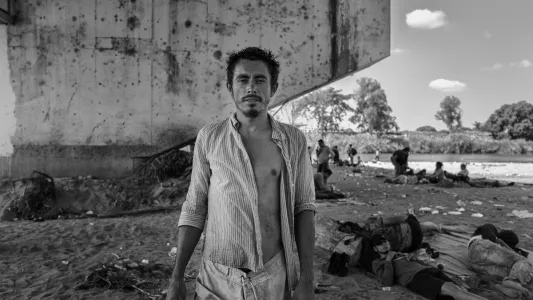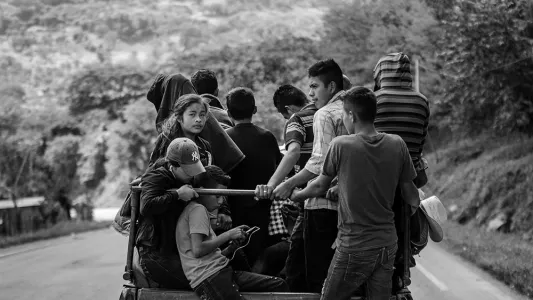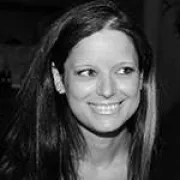Photographer Ada Trillo (@adatrillophotography) is a Juarez-El Paso native who now resides in Philadelphia. She has a Fashion Degree from Istituto Marangoni in Italy and a Business Degree from Drexel University. She is a self-taught photographer who continuously seeks to learn more about the medium – by taking both group educational courses and private classes in Photography.

Both the subject and the pictures of her body of work La Caravana del Diablo (2020), have a deep impact – not only socially and politically, but also artistically. Growing up between El Paso and Juarez, a binational metroplex, Trillo was always aware of how borders can both define and divide communities. Living on one side of the border and going to school on the other side, going back and forth across the border, made her witness the desperation behind immigration on more than one occasion. “I saw what many of the immigrants were willing to do, to sacrifice just to get to the other side of an imaginary life, something that I was allowed to do every day.” Trillo would reflect on how some of them would even be willing to risk their lives to get away to safety. She started studying Photography around the time Former U.S. President Donald Trump had begun announcing the construction of a “big, beautiful wall”, between the US and Mexico. “A concrete barrier”, as Trump had called it, that “would serve to stop the flow of illegal immigrants and drugs over the border”. Trump didn’t stop at barring asylum seekers from entering the US, he also threatened to impose tariffs and stop all foreign aid to Central American countries.
© Ada Trillo
Trillo emphasized covering the US exclusions, resulting – not only from the physical borders – but from the long-standing borders of race and class, as well. La Caravana del Diablo was all about documenting the dangers that immigrants face. In January 2020, the Hondurans organized a massive migrant caravan that was supposed to travel through Guatemala and into Mexico, to flee violence and poverty. The caravan kept going for 8 whole days, before it crossed the Suchiate River into Mexico and was met by the National Guard.

“I focused on La Bestia. As many as half a million Central American migrants hop aboard freight trains, annually.” La Bestia (The Beast) takes them from Mexico to the United States. “They sit atop and grip onto the sides of La Bestia’s screeching steel railcars”, Ada says, that might result in “an accidental amputation and/or death” if they slip. Sexual violence against women is also a high probability. Throughout the journey, “the migrants are subject to extortion, theft, rape and even murder, if they fail to pay the so-called protection fees established by gangs and cartels that control the north route”. Sadly, organized crime groups are not the only ones seeking to profit off of migrants by exploiting them. “Train conductors also take part in the chain of extortion by demanding bribes, particularly of women and families with young children.” Unfortunately, most crimes that take place on board ‘La Bestia’ go unreported, since most migrants are undocumented and afraid to speak up.
© Ada Trillo
During the journey, Ada was faced with both practical and emotional difficulties. She admits to struggling with walking miles and miles, having no basic amenities and facilities and sleeping on the ground. “It was dangerous, but I was lucky. The migrants always protected me. Their kindness can’t be understated.” On a long journey like that, everything aches.
Just the physical strain on the body alone, the need to keep the sun off of your face, keep hydrated and fed is hard enough.
As hard as it gets for children, adults and the elderly, for pregnant and/or nursing mothers, they mostly have one choice: to make it across the border. Otherwise, they have to turn back or end up stranded in a different city. All of this hardship and the thoughts that would go through Trillo’s mind, eventually had an emotional toll on her. “All this can be emotionally distressing and in a practical sense, disastrous. It’s emotionally disturbing for me because these people are no longer ‘the migrants on the caravan’, they are my friends. We have traveled together and shared life stories and kept each other safe.”
© Ada Trillo
Trillo calls the ban on political asylum “a crime against humanity, a matter that “needs to be addressed and lifted immediately”. It’s obvious – both in her words and in her photographs – that she feels very strongly about this. Her images are a combination of documentary and fine art and they speak loudly. Her intention is to educate us, bring attention to the problem and amplify the voices of the people who can’t speak for themselves. Upon asking Ada if she has a favorite photograph from the La Caravana 2020 project. She said it’s Joel Crossing the Suchiate River. “This one-legged young man walked through two countries on crutches. He swam across the Suchiate River. For me, he is the true definition of a survivor”.

Trillo’s bravery goes beyond spending those days on ‘La Bestia’. Daring to document this traumatic event for the world to see proves just how courageous she is. She is looking to expose the truth, the dignity, the humanity in us all. “
For me, photography is love. Photography is showing people a new perspective through my work.


















